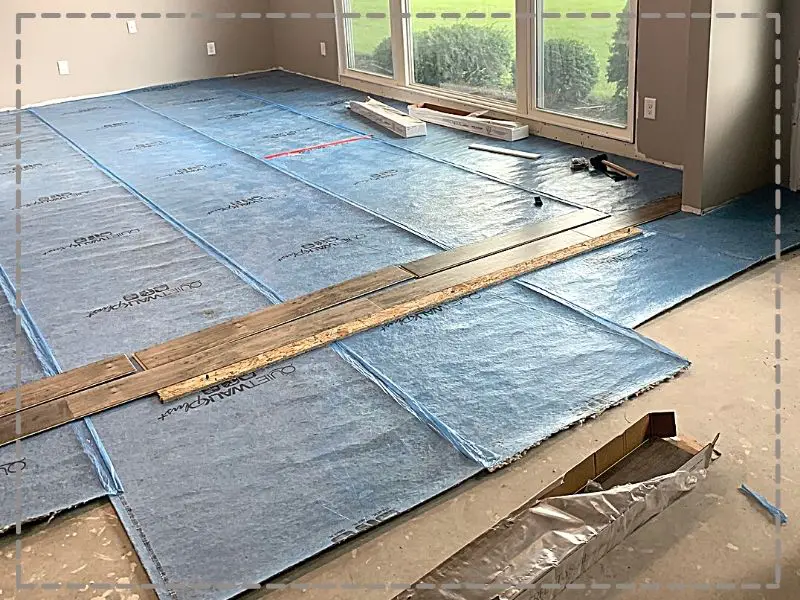Have you ever stared at a box of laminate flooring, wondering if that extra layer of padding was truly necessary? It seems like an optional add-on, but what if it’s the key to a long-lasting, beautiful floor? We’ve all been there, questioning those seemingly optional additions, but the truth is underlayment isn’t just another product on the shelf – it plays a critical role in the longevity and comfort of your laminate flooring.

Image: phenergandm.com
Laminate flooring has gained immense popularity for its stunning appearance, durability, and ease of maintenance. However, beneath its sleek surface lies a layer that often gets overlooked – the underlayment. This often-forgotten component contributes significantly to the overall performance and lifespan of your laminate flooring. It’s like the foundation for a house – it might not be visible, but it’s the backbone of the whole structure. So, let’s dive into the world beneath the planks and discover the secrets to a happy, healthy, long-lasting laminate floor.
The Unsung Hero: Understanding the Role of Underlayment
Think of underlayment as a secret weapon, quietly working behind the scenes to enhance your flooring experience. Unlike the visible laminate planks that grace your home, underlayment acts as the unseen hero, providing a multitude of benefits:
- Soundproofing: Imagine a world where your footsteps sound like gentle whispers instead of a thundering chorus. Underlayment significantly reduces noise transmission, turning your home into a haven of tranquility. This is particularly important for multi-level homes, where footsteps can reverberate throughout.
- Comfort: Step onto a soft, cushioned floor and say goodbye to hard, unforgiving surfaces. Underlayment creates a more comfortable walking experience, making your home feel more inviting and relaxing.
- Protection: Underlayment acts as a protective barrier against moisture and temperature fluctuations, preserving the integrity of your laminate flooring. It can help minimize the impact of spills and shield against unwanted changes in room temperature.
- Stability: Like placing a sturdy base under a wobbly table, underlayment provides a stable foundation for your laminate flooring. This prevents movement, squeaking, and potential damage over time.
- Leveling Irregularities: Imagine your flooring as a canvas – a smooth, even layer that creates a beautiful, uniform surface. Underlayment can help even out minor irregularities in the subfloor, ensuring a seamless appearance and a more secure installation.
Do You Really Need it? Navigating the Underlayment Dilemma
Now that we understand the benefits of underlayment, a critical question remains: Do you really need it? There’s no one-size-fits-all answer as the decision depends on a few key factors.
- Subfloor Condition: A smooth, solid subfloor can sometimes get away with using a thinner underlayment or opting for a low-profile version. But if your subfloor is uneven, damaged, or prone to moisture issues, a high-quality underlayment becomes a necessity.
- Room Location: Underlayment is a must in rooms where you need extra noise reduction and comfort, like bedrooms, living rooms, and play areas. For rooms with less foot traffic, or those with existing sound insulation, you can consider a lower-profile option.
- Lifestyle: If you have a busy household with children and pets, investing in a thicker, more robust underlayment can be a sound decision to protect your floor from wear and tear.
Choosing the Right Underlayment: A Step-by-Step Guide
Now that you’ve considered the factors above, you’re ready to select the perfect underlayment for your needs. Here’s a breakdown to guide you:
1. Understand Your Subfloor: Take a close look at your existing subfloor. Is it level, free from cracks, and impervious to moisture? These factors will influence your underlayment choice.
2. Determine Your Needs: Are you primarily focused on soundproofing, comfort, or moisture protection? Prioritize your needs and seek out underlayment solutions that meet them.
3. Consider Underlayment Materials:
- Foam: Often the most budget-friendly option, foam underlayment offers excellent soundproofing and comfort. However, it’s not always the best choice for areas prone to moisture.
- Cork: Known for its natural qualities, cork is a great option for soundproofing, comfort, and even temperature regulation. It’s on the higher end of the price spectrum, but its durability and sound-absorbing properties make it a sound investment.
- Rubber: This material excels in moisture resistance and offers excellent durability, making it ideal for areas with moisture concerns.
- Fiberboard: Fiberboard underlayment provides a firm base that’s excellent for leveling minor subfloor imperfections. It’s less effective in damp environments, but it’s a good option for soundproofing.
4. Factor in Thickness: Thicker underlayment provides greater sound reduction and comfort, but it may require adjustments to door casing height or trim.
5. Consult with a Flooring Professional: Seek advice from a trusted flooring professional to ensure you choose the best underlayment for your specific project.

Image: www.bestlaminate.com
Do You Need An Underlayment For Laminate Flooring
Underlayment: More Than Just a Layer
Choosing the right underlayment is like choosing the right foundation for your laminate flooring. It’s an investment that can significantly impact the longevity, comfort, and overall satisfaction you derive from your floor. By taking the time to understand your needs and carefully selecting the appropriate underlayment, you can ensure a long-lasting, beautiful, and comfortable floor that delights you for years to come.
Remember, underlayment might not be the flashiest part of your flooring project, but it’s the unseen hero that quietly ensures your floors perform their best, fulfilling their purpose and bringing you joy for years to come.





